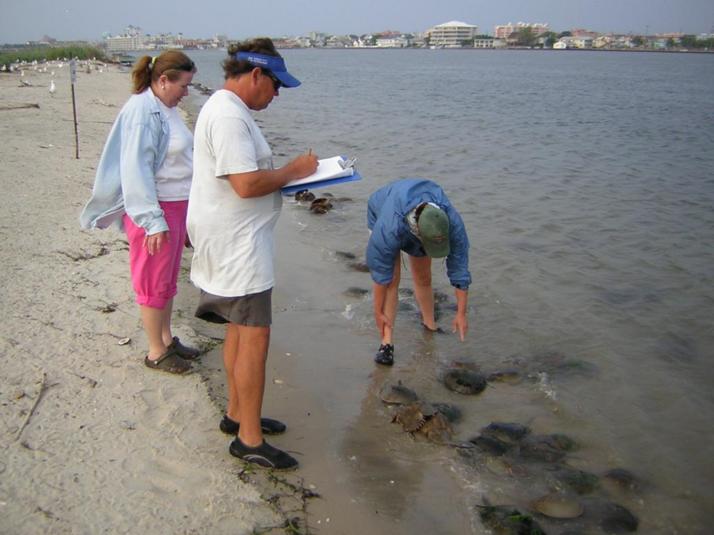Cooperative Projects
The Coastal Fisheries Project provides support to the projects listed below. Please go the activity's website to find out more about how the Coastal Fisheries Project is involved.

-
Horseshoe Crab Spawning Survey with the Maryland Coastal Bays Program. The department has an internet site to report horseshoe crab spawning activity. if you see horseshoe crabs spawning on coastal bays beaches
please report this activity. An overview of this program is featured in the
video below.
-
Volunteer Angler Surveys provide an opportunity for recreational anglers to get involved with fisheries management. Data provided from recreational fishing trips helps fisheries managers characterize the catch and harvest.
-
Coastal Atlas The Coastal Atlas' Ocean mapping tool allows users to view ocean data and access tools to understand and balance multiple ocean uses, including shipping, offshore renewable energy, recreation and fishing. The Coastal Fisheries Project has worked with commercial and recreational fishermen to ensure that areas important to fishermen are represented accurately on the Coastal Atlas.
Cooperative Fisheries Management
Most of the fish that people are interested in along Maryland's coast migrate into other state or federal waters. Species include summer flounder, black sea bass, horseshoe crabs, striped bass, spiny dogfish, tuna, and many more. State and federal governments must work together to make management decisions for the fish that share their waters. For example, a large percentage of striped bass are hatched in the Chesapeake Bay. Once they have grown, striped bass migrate into the Atlantic Ocean and travel in waters along the coast from Maine to North Carolina. Because most of the states along the coast have fisheries for striped bass, these states must cooperatively manage striped bass fisheries.
There are many participants in cooperative management. At the head of management is the National Marine Fisheries Service (nmfs.noaa.gov/), which is the federal agency responsible for conserving our nation's marine resources, including fisheries. The National Marine Fisheries Service makes rules about fishing in federal waters (3-200 miles offshore). The Magnuson Stevens Fishery Conservation and Management Act of 1976 created the Mid-Atlantic Fisheries Management Council (mafmc.org/) to help the National Marine Fisheries Service establish rules for fisheries in federal waters off mid-Atlantic states. This council makes recommendations to National Marine Fisheries Service (NMFS) which the service can then choose to establish as rules. Sometimes the National Marine Fisheries Service and the Mid-Atlantic Fisheries Management Council do not agree on a management decision. When this happens, National Marine Fisheries Service has the authority to make the final decision.
At the state level, the Atlantic States Marine Fisheries Commission (asmfc.org/) makes rules about fish that use state waters (0-3 miles offshore) in multiple Atlantic states. Many fish found in Maryland are managed by the Atlantic States Marine Fisheries Commission.
Sometimes a species occurs in both state and federal waters and is managed by both the Atlantic States Marine Fisheries Commission and National Marine Fisheries Service. State and federal rules are usually the same, but occasionally they differ. Typically, state laws apply in state waters and federal laws apply in federal waters, but there are exceptions. For example, spiny dogfish use both state and federal waters. The National Marine Fisheries Service and the Atlantic States Marine Fisheries Commission occasionally have different rules about how many spiny dogfish may be captured. Commercial fishermen holding federal permits for spiny dogfish must follow federal rules, even in state waters. As the head of management, National Marine Fisheries Service can overrule any state decision it feels will not best promote a sustainable fishery.
To make well-informed decisions about management, both federal and state management groups are advised by committees of scientists, technical experts and commercial and recreational fishermen (see 'Other Cooperative Programs' below). The general public can also contribute to cooperative management by voicing concerns or insights at public meetings. Most agencies are required by law to allow for public input in their rule-making process. The Maryland Department of Natural Resources Fishing and Boating Services staff serves on many of these committees to represent Maryland fisheries and fishing opportunities. Altogether, these established organizations work to ensure accuracy, fairness and representation in decision-making. In this way, cooperative management is necessary to successfully preserve fishing for generations to come.
Other Cooperative Programs
The Coastal Fisheries Program works with several additional organizations to meet the goals of their programs.
Maryland Coastal Bays Program
Maryland Coastal Bays Program (mdcoastalbays.org) is a partnership of federal, state, and local agencies. This partnership works together to protect and restore the Maryland Coastal Bays.
Atlantic Coastal Cooperative Statistics Program
The Atlantic Coastal Cooperative Statistics Program is a cooperative state-federal program to design, implement, and conduct marine fisheries statistics data collection programs and to house those data into a single data warehouse that will meet the needs of fishery managers, scientists and fishermen.
Other Department Activities in Maryland's Coastal Bays
Maryland Department of Natural Resources has several groups working in Maryland's Coastal Bays. For example, water quality monitoring is conducted throughout the bays by Maryland Department of Natural Resources Tidewater Ecosystem Assessment Division. More information on what additional activities are on-going in Maryland's Coastal Bays is available on the Coastal Bays webpage and Chesapeake and Coastal Services webpage.